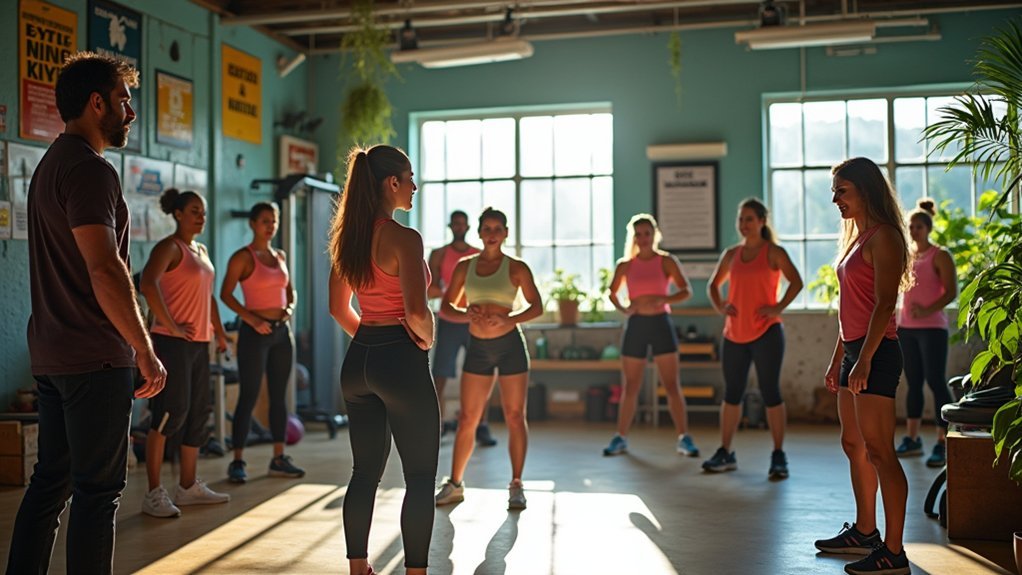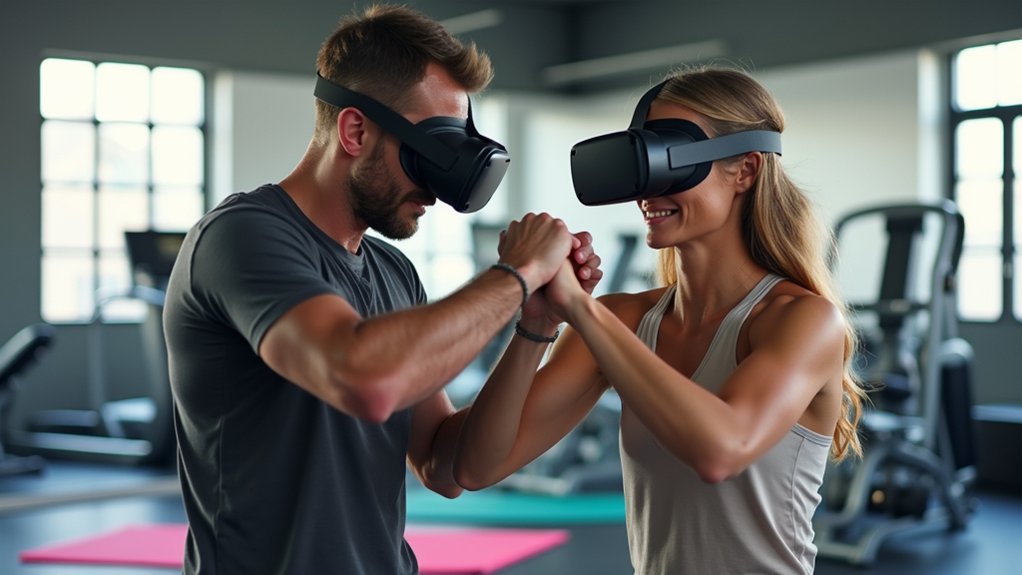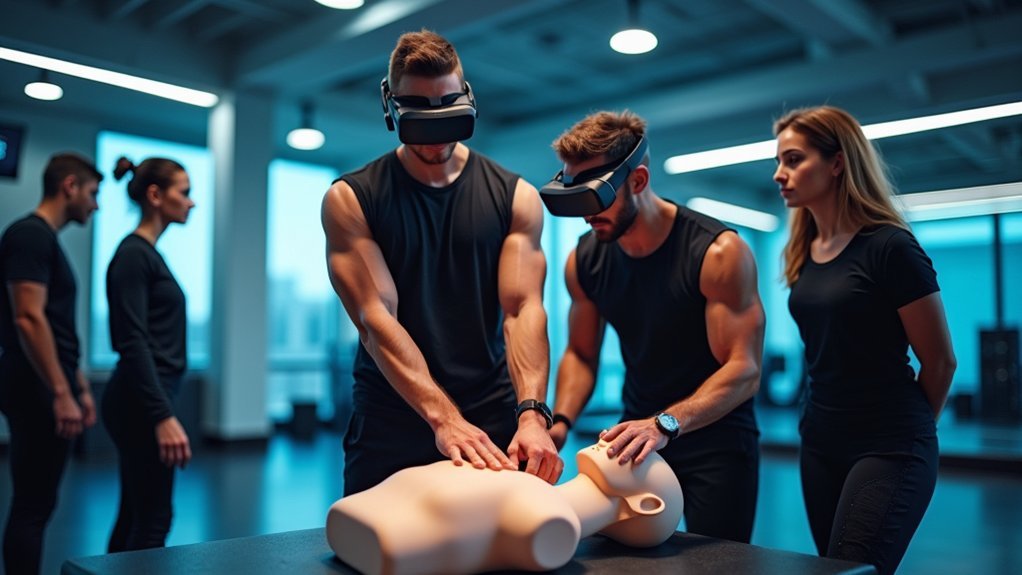You’ll need to start with a high school diploma or GED, then choose an accredited certification program from organizations like NASM, ACE, or ISSA. Obtain CPR and AED certification for client safety, and expect to invest $600-$1200 for courses lasting one to six months. Master VR technology and equipment operations while developing specialized virtual reality programming skills. Secure professional liability insurance, understand VR safety protocols, and maintain continuing education credits to stay current. The extensive steps ahead will guide your complete transformation.
Research VR Fitness Certification Requirements and Prerequisites

Before you can launch your career as a VR fitness coach, you’ll need to meet specific certification requirements that form the foundation of your professional credentials.
Start with a high school diploma or GED, as this serves as your educational baseline. You’ll also need CPR and AED certification to guarantee client safety during training sessions.
A high school diploma and CPR/AED certification establish the essential safety foundation for VR fitness coaching careers.
Research various fitness certification organizations like NASM, ACE, and ISSA to find certification programs that align with your career path.
These Personal Trainer Certification courses typically take one to six months to complete and cost between $600-$1200.
Remember that maintaining your certification requires earning continuing education credits regularly.
Compare program formats, costs, and specialization options to choose the certification that best supports your VR fitness coaching goals.
Choose the Right VR Fitness Instructor Certification Program
Once you understand the basic requirements, selecting the right VR fitness instructor certification program becomes your next priority.
You’ll want to choose an accredited certification program recognized by organizations like NASM or ACE to boost your credibility. Look for thorough curricula that cover exercise science, virtual training techniques, and client engagement strategies specifically designed for VR environments.
Consider programs offering flexible study options like online courses or blended learning to fit your schedule.
Evaluate the support provided, including study materials, practice exams, and networking opportunities with other fitness professionals.
Research the program’s reputation by reading student reviews and checking job placement rates. This guarantees you select a certification program that aligns with your career goals and maximizes your success in the VR fitness industry.
Master Essential VR Technology and Equipment Operations

Technical mastery of VR equipment separates successful virtual fitness coaches from those who struggle with constant interruptions and frustrated clients.
You’ll need thorough knowledge of VR headsets, motion sensors, and fitness tracking devices to deliver seamless training sessions that keep clients engaged.
Essential steps for mastering VR technology operations:
- Learn equipment setup and troubleshooting – Master calibration processes, connectivity issues, and hardware maintenance to minimize downtime during sessions.
- Understand interactive fitness software – Familiarize yourself with virtual training environments and workout applications that enhance client motivation.
- Stay current with technological advances – Follow VR technology trends and pursue specialized certifications to expand your coaching capabilities.
Proper equipment operation directly impacts client satisfaction and your professional reputation.
Investment in VR-focused fitness equipment training guarantees you’re prepared for this rapidly growing market segment.
Develop Specialized Skills in Virtual Reality Exercise Programming
Beyond operating VR equipment proficiently, you must develop expertise in creating specialized virtual reality exercise programs that deliver measurable fitness results. As a Certified Personal Trainer entering this $2.54 billion market, you’ll need an extensive understanding of biomechanics and exercise physiology to design safe, effective immersive workout experiences.
| VR Programming Skill | Application |
|---|---|
| Gamification Design | Boost client motivation through interactive challenges |
| Biomechanics Integration | Guarantee proper form and injury prevention |
| Platform Customization | Adapt Oculus/HTC Vive for specific fitness goals |
| Progress Tracking | Monitor client performance within virtual environments |
| Exercise Modification | Adjust intensity based on individual capabilities |
Virtual reality exercise programming requires continuous blending of traditional fitness methodologies with cutting-edge technology. Pursuing continuing education in emerging VR trends will position you competitively as clients increasingly demand innovative training solutions.
Obtain CPR and AED Certification for VR Fitness Environments

While VR fitness environments create immersive workout experiences, they also present unique safety challenges that require you to maintain life-saving certifications.
CPR and AED certification is essential for personal trainers working in these innovative fitness environments, where clients engage in intense physical activity that could trigger cardiac emergencies.
You can complete your certification through convenient online courses before your final exams. The training covers recognizing cardiac arrest, performing CPR, and operating AED devices effectively.
Key certification benefits:
- Enhanced Safety Protocols – You’ll respond confidently to emergencies in VR fitness settings
- Client Trust Building – Demonstrates your commitment to their well-being and professional standards
- Career Requirements – Most employers require current CPR/AED certification for personal trainers
Remember to renew your certification every two years to stay current with updated safety guidelines.
Build Strong Communication and Motivational Coaching Abilities
Your ability to communicate clearly and motivate clients forms the foundation of successful fitness coaching. Strong communication skills enable you to demonstrate exercises effectively, explain complex concepts, and provide actionable feedback during workouts.
Practice active listening to understand your clients’ unique needs, allowing you to create personalized fitness plans that align with their goals.
Develop motivational coaching techniques through positive reinforcement and strategic goal setting to boost client engagement.
You’ll need to build rapport and trust by creating a supportive environment where clients feel comfortable sharing their concerns and celebrating victories.
Share your personal experiences and use storytelling to connect emotionally with clients. This approach makes workouts more relatable and inspiring, ultimately improving their commitment to long-term fitness success.
Complete Hands-On VR Fitness Training and Practical Experience
As technology revolutionizes fitness education, hands-on VR fitness training provides you with immersive scenarios that bridge the gap between theoretical knowledge and real-world application.
When you complete hands-on VR fitness training, you’ll gain practical experience that’s essential for developing into an effective fitness coach.
This extensive training approach offers you three key advantages:
- Enhanced Understanding of Body Mechanics and Exercise Physics – You’ll master proper form techniques and injury prevention strategies through realistic simulations.
- Improved Client Interactions and Communication Skills – VR scenarios help you practice motivational coaching and build rapport with diverse client personalities.
- Boosted Confidence and Competence – Completing this program makes you more marketable to employers while ensuring you can design tailored workout plans that meet individual client needs effectively.
Understand VR Safety Protocols and Risk Management
Building on your thorough VR fitness training foundation, you must master safety protocols and risk management to protect both yourself and your clients during virtual reality workouts.
Follow your certification organization’s specific safety protocols, as they’re designed to minimize VR-specific risks. Regularly assess clients’ health and fitness levels to identify contraindications before starting virtual sessions.
Adhering to certification safety protocols and conducting thorough client health assessments prevents VR-specific risks before virtual training sessions begin.
Maintain current first aid and CPR certifications since emergency preparedness is essential when clients are immersed in virtual environments. Secure adequate liability insurance coverage to protect against claims from injuries or equipment damage.
Conduct thorough risk assessments of your training environment, checking VR equipment functionality, clearing movement spaces, and ensuring proper ventilation. These precautions create safe, effective virtual fitness experiences.
Secure Professional Liability Insurance for VR Fitness Instruction
Professional liability insurance serves as your financial shield against lawsuits and claims that can arise from VR fitness instruction incidents.
As fitness instructors embrace virtual reality technology, you’ll need specialized coverage that protects against equipment malfunctions and space-related injuries during sessions.
Here are three essential considerations for VR fitness instruction insurance:
- Equipment Coverage – Guarantee your policy covers VR hardware malfunctions that could injure clients.
- Digital Session Protection – Verify coverage extends to remote training scenarios and virtual environments.
- Legal Defense Coverage – Confirm your policy includes legal fees and settlement costs.
Many insurance providers now offer policies specifically designed for personal trainers in the evolving fitness industry.
This coverage not only protects your finances but also enhances your credibility with clients who expect professional standards from certified instructors.
Maintain Continuing Education and Stay Current With VR Fitness Trends
Beyond protecting your practice with proper insurance, you must continuously expand your knowledge to excel in the rapidly evolving VR fitness landscape. Meeting continuing education requirements through specialized workshops and VR fitness certifications keeps you ahead in this projected $1.5 billion market by 2026.
You’ll enhance client engagement by mastering emerging platforms and applications that transform traditional workouts into immersive experiences.
Attend webinars exploring VR’s psychological benefits, including increased motivation and workout adherence. Join professional organizations dedicated to VR fitness for valuable insights and networking opportunities with industry leaders.
Professional VR fitness organizations provide crucial networking opportunities and insights into emerging psychological benefits that drive client motivation and adherence.
These connections help you discover cutting-edge technologies before competitors do. Implementing VR technology distinguishes you as a forward-thinking fitness trainer who appeals to tech-savvy clients seeking innovative training methods.
Your commitment to continuing education guarantees you deliver unique, engaging experiences that set your practice apart.
Frequently Asked Questions
How Long Does It Take to Become a Certified Fitness Coach?
You can become a certified fitness coach in one to six months. If you’re dedicated and choose an intensive program like NASM, you’ll complete certification in just four weeks with focused studying.
How Do I Become a Qualified Fitness Coach?
You’ll need certification from accredited organizations like NASM, ACE, or ISSA by passing their exam. Get your high school diploma, CPR/AED certification, complete continuing education requirements, and build your client base.
Can You Make $100,000 as a Personal Trainer?
You can definitely make $100,000 as a personal trainer by building a strong client base, specializing in high-demand niches, setting competitive rates, and establishing your own business in affluent areas.
Is $300 a Month a Lot for a Personal Trainer?
$300 monthly isn’t excessive for personal training. You’re getting professional expertise, customized workouts, and accountability. It’s competitive pricing that breaks down to roughly $75 per session for quality fitness guidance.





Leave a Reply